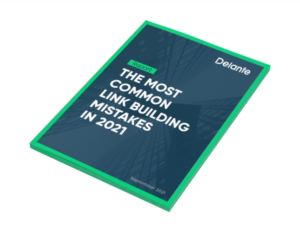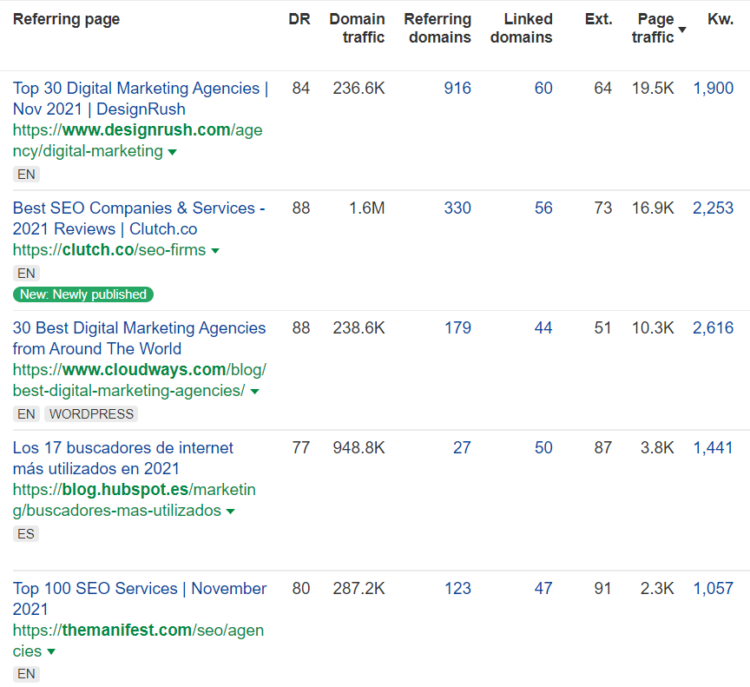How to Evaluate Domains for Link Building? A Step-by-step Guide by Delante

Would you like to learn what the link building process looks like from behind the scenes? What tools does an SEO agency need to conduct effective link building? In this article we’ll introduce you to the work of Delante specialists. Keep reading to discover tips that will help you verify linking domains.
Table of contents:
- Linking in the SEO process
- What do we evaluate when choosing linking domains?
- What does it look like in real life?
- The takeaway
You’re here because you want to learn how we do referring domain research – that’s clear. But to give you an idea of what a well-run link-building process looks like, we’ll start with explaining why SEO agencies actually offer it and why its effects are so important to Google’s algorithms.
Linking in the SEO process
Link-building is a process that allows you to build an appropriate profile of links leading to the website from referring domains. It’s supposed to increase the website’s authority and, in turn, improve its visibility.
There is no perfect recipe for link building, but there is a set of rules that our Delante team follows in order to gradually increase the most important parameters of the client’s domain.

The first point in the linking process (aside from analyzing key phrases, of course) is to create a base of domains referring to the client’s site, and this is what this article is largely devoted to.
Why is this part so important? Without valuable domains the linking process can’t be conducted; of course, some people still use spammy black hat SEO techniques such as link farms, but this isn’t modern and professional SEO that brings real benefits to the site. Especially when talking about long-term activities.
The importance of valuable domains can be stated in the following way: Google’s algorithms, such as Penguin, along with all other minor updates within the search engine (e.g. Google Link Spam Update July 2021), increase the positions of sites whose backlinks come from a proven and trusted source. When a site that Google trusts links to another site, it shares its reputation with that site through the so-called link juice, meaning the power that can be transferred.
Why does it happen?
In a nutshell – Google assumes that since a valuable website invites its users to another page, this page is equally trustworthy. As a result, the reputation of the linked domain grows and it’s displayed higher in the search results. Analogically, if the original website has a high SPAM score and generates low-quality links, the links coming from it may worsen the position of the target website.
Important: When evaluating the quality of a site, Google’s algorithms take into account not only the number of specific links that lead to it but also the number of different domains they come from. Link diversity is, therefore, an important issue – the more unique the sources, the better. We never accept a situation where the increase in links to the client’s domain is disproportionate and dominated by a single source.
What do we evaluate when choosing linking domains?
You already know that the right choice of domains is key to successful linking. In this section, we’ll tell you how and according to which criteria we select referring domains for our clients.
1. Parameters
Because we follow all the principles of good data-driven SEO, we take data into account when building a reliable link profile for our clients’ sites. This includes information from proven tools on traffic, visibility, and page topics, as well as domain trust metrics specific to each tool.
This tool is great for analyzing backlinks. In the process of checking sites for linking, it helps our specialists gather information on how valuable the potential referring domain is.
Domain Rating is one of the most important Ahrefs metrics we take into account. It tells us about the quality of the domain. DR has a value from 1 to 100, and the higher it is, the better the quality of the site and the potential link juice it can pass on.
Among other things, Ahrefs gives the ratio of linking domains to the linked ones, helping to assess the value of the site for the linking process. By finding out, among other things, the DR and link juice potential, we eliminate domains that are already exploited or spammy and select those that have the power to share their authority.
In Ahref,s you can also check URL Rating – what is the difference between these two parameters? URL rating can be checked for each site subpage, whereas DR tells you about the average condition of the whole domain, and is a more important factor for choosing referring domains.

To learn more, check out our entry: How Can Ahrefs Help with Link Building?
It’s a multifunctional tool that allows us to examine and monitor site parameters.
When talking about linking domains, we’ll focus mainly on Domain Authority. Its definition and function are analogous to the Domain Rating by Ahrefs, which you’ve just learned about. Domain Authority is a parameter that shows the ranking potential of a given site. The DA scale is 1-100 – the higher the score, the more valuable the site.
Factors influencing the DA score include MOZ’s own parameters, such as MozRank, MozTrust and the number and quality of inbound links. Domain Authority also shows the relevance of a site to its industry or topic, which helps us do referring domains research accurately.
Importantly, MOZ also focuses on the SPAM Score – something we care about.

Semrush allows us to determine the Authority Score of the domains we check. This parameter summarizes information related to backlinks, traffic within the site, the ratio of nofollow and dofollow links, and others.
- Semstorm
Semstorm allows us to perform a detailed competitive analysis (including comparisons) and examine the visibility of individual domains. Thanks to it, we can decide where to link from to match the actions of our customers’ competitors. We also check here the estimated organic traffic on particular domains.
2. The number of outbound links
We want to choose potential referring domains that don’t distribute their link juice to many sources. As the most valuable linking sites, we choose domains that don’t contain many links, and therefore the transferred link juice is much higher.
SEO-wise, domains with fewer outgoing links are more valuable than domains with many outgoing links – the tools described above help us recognize the appropriate proportion and focus of link juice.
3. Topic relevance
As the majority of SEO tools and Google’s algorithms tell us, the domains from which we link to our clients’ sites should be in line with or neutral to the profile of a given industry (this principle, and backlinks from industry-specific sites, helps boost indicators such as Trust Flow developed by Majestic).
For example, links to a beauty salon from an automotive site aren’t the best idea. We can use general sites for such clients. However, when talking about lifestyle forums we link to both beauty salons and pet stores.
4. Diversity
Diversity is the keyword when choosing the right domains to link to. In the link building process, we select relevant links not only to the homepage (although this is the first phase of linking), but also to categories, products, and blog articles – all for relevant keyword phrases.
We also diversify the types of links and their publication spots: they can range from short posts on social media or bookmarking sites to longer content such as backlink articles.
Paid articles are another type of links we obtain for our clients. These are long, high-quality texts, written with the use of data-driven tools and additionally supported by our linking. Thanks to this, they give about 2-3 times better results than if they were simply written and published, even on the same page.
5. Competition
You can have your own linking strategy and trusted sites, but your market rivals are constantly on alert. Reaching the TOP3 positions in the search results requires the ability to stay ahead of the competitors. That’s why we analyze links created by competitors and acquire our own backlinks from the same domains.
For this purpose, we usually use Ahrefs (although it’s also possible to benefit from Semstorm). This tool shows pages with links leading to competitors’ sites, and also indicates their parameters (DR, UR, number of backlinks, the number of links coming from the subpage with competitors’ links).
Thanks to that, we can easily follow the latest activity of our competitors and keep up with their actions.

Important! After the domain research and analysis phase, it’s time for testing – we never check the effectiveness of domains on our clients’ sites. Before we use a site to obtain backlinks as part of the SEO process, we analyze them on our own domains to verify whether Google interprets them correctly and improves the positions of the sample subpage or phrase.
What does it look like in real life?
- Let’s imagine that the client’s website has parameters DR=17 and DA=12 (these are the ones you can check in Ahrefs and MOZ).
- When searching for linking domains suitable for this site, we’ll first choose sites with parameters higher than the current parameters of our site. Since at the first stage we’re boosting the homepage, we’ll aim for backlinks from domains with parameters close to DR and DA >30 (lower will be too weak, usually quality sites start around 30).
- When we manage to raise DR and DA to 30, we decrease the quantity of links and increase their quality, raising parameters to min. 40.
- During the link-building process, Google’s trust in the website gradually increases. By measuring it with professional SEO tools, we can constantly control its level by adjusting domain parameters and link types. When the website reaches high DR/DA and the most important phrases already appear in TOP10, we can fight for higher positions with more expensive links related to specific key phrases (e.g. paid articles).
The takeaway
When checking potential referring domains for our clients, we are primarily guided by hard data that we obtain from proven SEO tools. It’s crucial that backlinks come from valuable domains with parameters higher than those of the client’s website.
During the process, we always take care of proper diversification of links, and we match their specificity to a particular page so that both DA or DR and subject matter are well balanced.
Importantly, each created backlink is indexed in three different commercial tools to ensure that it’s checked by Google robots.



